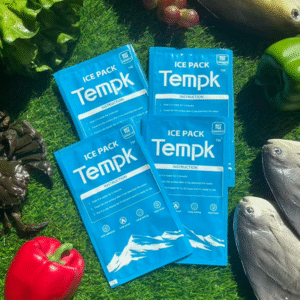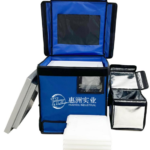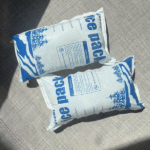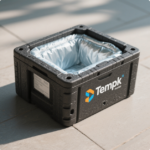Dry Ice Packs for Seafood Shipping: Eine vollständige Anleitung für 2025
Shipping seafood requires precise temperature control to maintain freshness and prevent spoilage. Dry ice packs are a vital tool in ensuring that seafood remains frozen during long transit periods. This comprehensive guide delves into how dry ice works, the best practices for packing seafood, and the regulatory requirements for shipping with dry ice. Whether you’re a seafood distributor or just starting, this guide will equip you with the knowledge to ship your products safely and efficiently.
-
How do dry ice packs preserve seafood Während des Versands?
-
What is the recommended amount of dry ice for seafood shipments?
-
What are the best practices for packing seafood using dry ice?
-
How does dry ice compare to other cooling methods like gel packs?
-
What are the latest trends in seafood shipping for 2025?
How Do Dry Ice Packs Preserve Seafood During Shipping?
Dry ice packs are the ideal solution for maintaining sub-zero temperatures during seafood transport, preventing thawing and preserving product quality. Dry ice sublimates directly from solid to gas at -78.5°C (-109.3° F), providing an efficient cooling method without any water residue. This feature is particularly beneficial in preventing soggy or contaminated packaging, which is often a risk with traditional ice.
Meeresfrüchte, being highly perishable, is extremely sensitive to temperature fluctuations. When exposed to temperatures higher than freezing, seafood can deteriorate rapidly, affecting texture, schmecken, und Sicherheit. Dry ice ensures that seafood remains in a frozen state for an extended period, maintaining its optimal freshness until it reaches the destination.
Key Benefits of Dry Ice for Seafood Shipping
-
Längere Kühldauer: Dry ice keeps seafood frozen for up to 72 Std., depending on the package size and insulation used.
-
No Water Residue: Im Gegensatz zu traditionellem Eis, Trockeneis untermauert in Gas, ensuring no water buildup that could spoil the seafood.
-
Superior Cold Temperatures: At -78.5°C (-109.3° F), dry ice offers much colder temperatures compared to regular ice (0°C or 32°F), making it ideal for frozen seafood.
| Kühlmethode | Temperatur | Dauer | Ideal für |
|---|---|---|---|
| Trockeneis | -78.5°C (-109.3° F) | 24-72 Std. | Gefrorene Meeresfrüchte, long transit |
| Gelpackungen | 0-8°C (32-46° F) | Variiert | Short-distance shipments |
| Eisbeutel | 0°C (32° F) | Variiert | Less temperature-sensitive items |
What is the Recommended Amount of Dry Ice for Seafood Shipments?
When shipping seafood, the right amount of dry ice ensures that the products remain frozen throughout the journey. The amount of dry ice you need depends on several factors:
-
Shipment Duration: Longer shipments require more dry ice to maintain low temperatures.
-
Umgebungstemperatur: If the shipping route involves high ambient temperatures, additional dry ice may be necessary.
-
Package Size and Insulation: High-quality insulated containers reduce sublimation rates and preserve the cold temperature longer.
How Much Dry Ice to Use?
In der Regel, verwenden 5-10 Pfund Trockeneis pro 24 hours of transit for every 15 quarts of cooler space. This can vary based on external factors like temperature and the quality of insulation. For longer shipments or hotter routes, it’s essential to adjust the amount of dry ice accordingly.
Dry Ice Sizing Calculator for Seafood Shipping:
Use the following formula to determine the amount of dry ice required:
Zum Beispiel, Versand 20 lbs of seafood for 48 hours with an average insulation cooler (box efficiency = 1.2) would require:
Best Practices for Packing Seafood with Dry Ice
Proper packing ensures that your seafood stays frozen while also protecting it from damage during transit. Here are the key best practices:
-
Verwenden Sie isolierte Behälter: Insulated containers help maintain the cold temperature for longer, especially when used with dry ice.
-
Separate Seafood and Dry Ice: To avoid freezer burn, keep seafood separate from direct contact with dry ice using moisture-resistant bags.
-
Layer Dry Ice Properly: Place dry ice at the top of the container, Als kalte Luft sinkt. This method, known as the “cold dome,” ensures that the seafood stays at the right temperature.
-
Stellen Sie eine ordnungsgemäße Belüftung sicher: Seit Trockeneis unterming in Gas, it’s essential that the container is vented to allow gas to escape, preventing dangerous pressure build-up.
Safety and Regulatory Considerations for Using Dry Ice
Since dry ice is classified as a hazardous material (Und 1845), shipping with dry ice requires compliance with several safety regulations:
-
Richtige Kennzeichnung: Mark packages with “Carbon Dioxide, Solid” and include the UN 1845 Etikett.
-
Vorsichtsmaßnahmen zur Handhabung: Always use gloves and goggles when handling dry ice to avoid frostbite.
-
Belüftung: Ensure that the container is not airtight, as this can cause dangerous pressure accumulation.
2025 Trends in Seafood Shipping
The seafood shipping industry continues to evolve, mit sustainability and efficiency taking center stage in 2025. Emerging technologies and new shipping solutions are improving the way seafood is transported, with a focus on reducing environmental impact and enhancing cold chain visibility.
-
Nachhaltige Trockeneisproduktion: Biodegradable dry ice packs and carbon capture technologies are gaining traction to reduce emissions.
-
Advanced Temperature Monitoring: Real-time tracking systems, including Bluetooth and BLE sensors, are helping businesses monitor temperature conditions throughout the shipping process.
-
Hybridkühlungslösungen: Combining dry ice with phase change materials (PCM) or gel packs is becoming more common for temperature control over longer durations.
Häufig gestellte Fragen
Q: How long can dry ice keep seafood frozen?
A: Dry ice can maintain frozen conditions for up to 72 Std., depending on factors like insulation, Die Menge an Trockeneis verwendet, and the shipment’s duration.
Q: Can dry ice be used for overnight seafood shipments?
A: Ja, dry ice is ideal for overnight shipments as it provides rapid cooling and ensures that seafood remains at the correct temperature for quick deliveries.
Q: Is dry ice safe for live seafood?
A: NEIN. Dry ice is too cold for live seafood, and can kill delicate items like lobsters or oysters. Gel packs or PCM should be used instead for live shipments.
Schlussfolgerung und Empfehlungen
Using dry ice packs for seafood shipping is the best way to ensure your products arrive frozen and fresh, maintaining their quality during transit. By adhering to best practices for packing, Handhabung, und regulatorische Einhaltung, you can ensure safe and efficient shipping. Während sich die Branche weiterentwickelt, staying updated on the latest trends and innovations will help you remain competitive in the market.
Nächste Schritte:
-
Evaluate your shipping requirements and calculate the necessary dry ice for your shipments.
-
Use high-quality insulated containers and ensure proper ventilation.
-
Stay informed on 2025 trends like eco-friendly dry ice production and smart monitoring solutions.
Über Tempk
Tempk is a leading provider of dry ice solutions for cold chain logistics. We specialize in offering high-quality dry ice and advanced packaging systems tailored to the seafood industry. Our solutions are designed for efficiency, Sicherheit, und Nachhaltigkeit, ensuring your products arrive fresh and on time.
Contact us today for expert advice on dry ice solutions for seafood shipping.
























